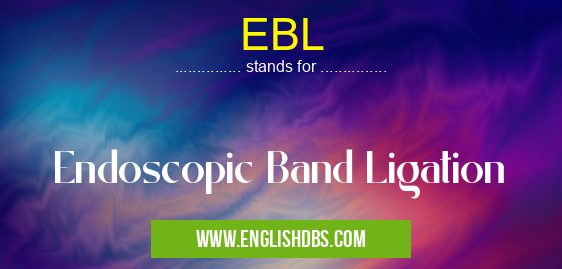What does EBL mean in CLINICAL MEDICINE
Endoscopic Band Ligation (EBL) is an endoscopic procedure used to treat gastrointestinal disorders. It involves the application of a single or double elastic band around an esophageal varix, which is a swollen vein in the lining of the esophagus. The band cuts off the blood supply to the area, causing the affected tissue to die and fall off. While this procedure is often used when other treatments have failed, it can also be done as a preventive measure for people at risk of developing varices from cirrhosis or portal hypertension. EBL is typically performed under general anesthesia, and most patients experience minimal discomfort during and after the procedure.

EBL meaning in Clinical Medicine in Medical
EBL mostly used in an acronym Clinical Medicine in Category Medical that means Endoscopic Band Ligation
Shorthand: EBL,
Full Form: Endoscopic Band Ligation
For more information of "Endoscopic Band Ligation", see the section below.
What Does EBL Mean?
EBL stands for Endoscopic Band Ligation. This term refers to a minimally invasive medical procedure that uses elastic bands to restrict and cut off the blood supply to an enlarged vein in order to reduce its size and prevent further bleeding. It is often used in patients who have esophageal varices, which are dilated veins on the surface of the esophagus near its junction with the stomach, found in those with cirrhosis or portal hypertension.
How Is EBL Performed?
During an EBL procedure, an endoscope (a thin tube with a camera on one end) is inserted down a patient’s throat into their stomach. Using this device as well as special instruments passed through it, elastic bands are placed around any enlarged veins present in order to cut off their blood supply and reduce their size. The procedure takes between 10 and 15 minutes and most patients experience minimal discomfort during its duration. Aftercare may involve avoiding strenuous activities for several days as well as pain medication if needed.
Benefits Of EBL
Endoscopic band ligation offers various benefits compared to traditional open surgery for treating GI disorders such as esophageal varices; these include reduced risk of infection due to performing the procedure endoscopically instead of through large incisions, no need for general anesthesia allowing for faster recovery time, less pain post-procedure due to much smaller wounds generated by placing elastic bands rather than making large incisions through skin and muscle, reduced stress levels due to shorter hospitalization times and quicker healing process overall.
Essential Questions and Answers on Endoscopic Band Ligation in "MEDICAL»CLINICAL"
What is Endoscopic Band Ligation?
Endoscopic Band Ligation (EBL) is a procedure that uses an endoscope, a device with a tiny camera and light attached to its tip, to place a small elastic band around the base of an enlarged internal hemorrhoid. This band cuts off the blood supply to the hemorrhoid causing it to shrink and eventually fall off.
Who can benefit from EBL?
EBL can be beneficial for anyone dealing with symptomatic internal hemorrhoids. Talk to your healthcare provider about whether or not this procedure is right for you.
How long does the procedure take?
The entire procedure typically takes less than 15 minutes. After paperwork is completed, you will be asked to lay on your back and relax while the endoscope enters through your anus and guides the placement of the elastic bands around your hemorrhoids.
Does EBL cause any pain?
With local anesthesia, there should be no discomfort during or after the procedure. However, minor pain and irritation may be experienced as the hemorrhoid begins to shrink over time.
What happens after the EBL procedure?
Following treatment, you may experience some mild rectal bleeding but this should subside within a few days. A sensation of fullness in your rectum may also occur that will improve over time as well. It’s advisable to rest for about 24 hours following treatment before returning to normal activities such as work and exercise.
Is there any downtime needed after an EBL procedure?
Most people can return to their daily activities immediately after treatment but it’s recommended that you avoid heavy lifting or strenuous activity for 24 hours following treatment.
How long do I need follow-up care?
Follow-up care depends on how severe your condition was prior to treatment and how quickly you recovered from surgery. Your healthcare provider may ask you to come in for regular checkups every 6 months following treatment or until all symptoms have subsided.
Final Words:
In conclusion, Endoscopic Band Ligation (EBL) is a minimally invasive medical procedure that uses elastic bands placed around enlarged veins in order to restrict their blood supply and reduce their size in people who have conditions such as cirrhosis or portal hypertension that cause esophageal varices. This relatively quick procedure has minimal risks associated with it while offering various benefits over traditional surgery including avoiding general anesthesia, reducing stress levels due to shorter hospitalization times and quicker healing process overall – all factors that can contribute positively towards patient outcomes following treatment.
EBL also stands for: |
|
| All stands for EBL |
